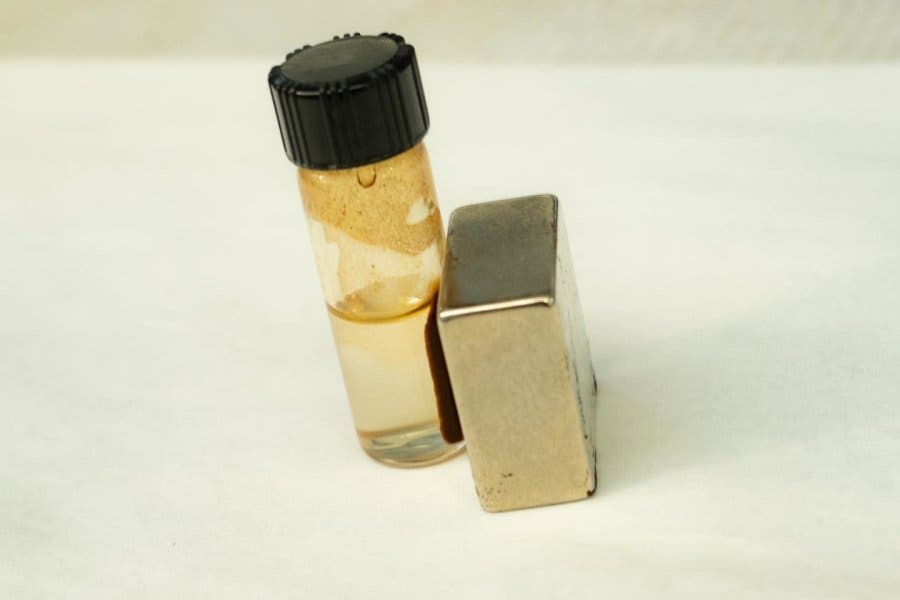New research from the Rice University may hold the key to scrubbing water clean of oily pollutants.

Image credits Jeff Fitlow / Rice University.
Water and oil don’t mix; except when they do. While the two fluids tend to separate readily, they’re able to mix just well enough to bind together. We call the resulting mixture an ’emulsion’. Not very dangerous in your kitchen — mayonnaise, for example, is an emulsion — but the phenomenon can cause problems in production water from oil wells. ‘Produced water’ comes from oil wells along with crude.
Looking for a way to scrub water clean in such cases, researchers from the Rice University have developed a nanoparticle-based solution that can remove 99% of the emulsified oil left over from oil wells.
The solution relies on magnetic nanoparticles that can attract oil droplets suspended in production water. The approach can scrub even those drops of oils that existing processes simply can’t remove.
Crude mixtures
Produced water is often laced with surfactants and other chemical compounds. These compounds are pumped into a crude oil reservoir to reduce the crude’s viscosity and help with extraction.
Now, believe it or not, you have some surfactants (surface acting substances) in your house; at least a bottle or a block of the stuff. You call it ‘soap‘. Soap helps you get clean by forcing water and fats (such as oils) to mix. One end of the soap molecule is hydrophilic (it ‘likes’ water) while the other end is hydrophobic (it ‘fears’ water). The hydrophilic end sports a water-soluble molecule that binds to water molecules, while the other end boasts a molecule that’s soluble in fats. Once each end has tied to the compounds of their affection, the soap molecule acts as a chain linking fat to water.

Image credits Smokefoot / Wikimedia.
In an oil well, surfactants force the crude to form stable emulsions with water. Because this emulsion is less viscous than the crude alone, it’s more easily pumped by derricks up to the surface. Most of the crude can be separated and then extracted from such emulsions. A fraction of about 5% is never or almost never recovered, and remains tied to the water.
“Injected chemicals and natural surfactants in crude oil can oftentimes chemically stabilize the oil-water interface, leading to small droplets of oil in water which are challenging to break up,” said Sibani Lisa Biswal, paper co-author and an associate professor of chemical and biomolecular engineering and of materials science and nanoengineering.
The paper combines Biswal’s expertise with magnetic nanoparticles with lead author Qing Wang’s experience with amines. The amines’ role is to guide the nanoparticles to oil droplets — amines carry a positive charge and oil is negatively-charged, so they attract. Magnets are then used to draw all the nanoparticles out of the solution.
They tested the nanoparticles in emulsions produced in the lab using either model oil or crude oil. In both cases, the team dropped their compound into the emulsions, shook them by hand or machine, and had oil-nanoparticle bonds form within minutes. Some of the oil floated to the top by this stage. The test tubes were then placed atop a magnet which drew the rest to the bottom — leaving clean water in between.
The research is remarkable as nanoparticles tend to aggregate (clump together) in high-salinity environments — such as those found in reservoir fluids — but the ones developed by the team remain stable in produced water. Furthermore, these nanoparticles can be treated with a solvent to recover the oil; they can be re-used after cleaning. So far, the team proved that the nanoparticles can go through six charge-discharge cycles while remaining effective. However, they suspect that the compound can remain effective for many more cycles.
Biswal’s team is now designing a flow-through reactor to scrub large quantities of produced water and automatically recycle the nanoparticles.
Household oil pollution is a huge issue nowadays, one that the team’s efforts may help address. Oil scrubbing may help protect the waterways for communities that can’t or don’t treat wastewater, or create an extra precaution for communities that do.


